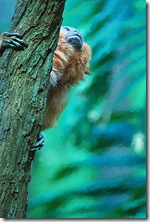For our endangered species of the week, I’m rerunning an earlier post about a very “Halloweeny” species – the Kauai Cave wolf spider! So read through and then learn 7 facts about spiders that you might not have known!
The Kauai Cave wolf spider (Adelocosa anops), also known as pe’e pe’e maka ‘ole in Hawaiian (from Earth’s Endangered Creatures) is found in only three caves on the Hawaiian island of Kauai. Like other wolf spiders, the Kauai Cave wolf spider doesn’t build a web to capture prey; it relies on speed and chases down its prey. Like all other spiders, it is venomous; it has three teeth for biting it’s prey. What’s really amazing about this hunting style is the fact that these spiders don’t have eyes (from Arkive)! According to the U.S. Fish and Wildlife Service Species Action Plan, the main threats to the spider are alteration of the caves and surrounding vegetation, non-native predators, and pesticide run-off.
So really, who cares? It’s just one little spider in a few caves in Hawaii. The answer is: when we protect these little spiders, we help ourselves. If pesticides from agriculture are bringing these spiders near extinction, there’s a pretty good chance those pesticides in water run-off are also affecting human populations. It’s in our best interest to clean up the water – the spiders win and humans win!
Seven Spooky Spider facts!
- North America is home to over 3,000 of the approximately 40,000 species of spider worldwide!
- The largest spider is the Goliath Bird-eating Tarantula, which can grow as large as a small dinner plate! Check out this National Geographic video: http://video.nationalgeographic.com/video/animals/bugs-animals/spiders-and-scorpions/tarantula_goliath/
- Spiders are not insects – they’ve got 8 legs and 2 body parts (as opposed to insects with 6 legs and 3 body parts)
- Spiders don’t have internal skeletons – they’ve got exoskeletons made of chitin (the second most common carbohydrate on Earth!)
- Some spiders spin webs each day and eat them at the end of the day to recycle the protein in the strands!
- Pound for pound, spiders’ silk is one of the strongest fibers on Earth!
- Spiders have been sent into outerspace! For more information on these “spidernauts”, see NASA’s website. Check out Esmerelda as she dines at zero-gravity on the international space station!
Sources:
Earth’s Endangered Creatures. 2006-2013. http://www.earthsendangered.com/. Accessed 10/31/2012.
NASA. 2011. International Space Station, Research Website. http://www.nasa.gov/mission_pages/station/research/news/space_spiders_live.html. Accessed 10/31/2012.
U.S. Fish & Wildlife Service. 2006. Kauai Cave Wolf Spider (Adelocosa anops), 5-Year Review: Summary and Evaluation.











 medium-sized woodpeckers (about 7 inches long) nest in live, old-growth pine forests, where they hollow out a cavity in which to nest and eat the insects found on the tree. When they hollow out the nest cavity, the tree seeps pitch or gum out of its wood around the cavity hole, that helps to protect the nest from tree-climbing snakes – so cool! Red-cockaded woodpeckers live in “family” groups, usually with one breeding pair and several helpers. The helpers are usually males from previous breeding seasons (daughters tend to disperse to new groups). The family group hollows out several nesting cavities, and the breeding male chooses the cavity in which to raise 2-5 chicks. Here’s another fun fact – the males incubate the eggs at night! The woodpeckers
medium-sized woodpeckers (about 7 inches long) nest in live, old-growth pine forests, where they hollow out a cavity in which to nest and eat the insects found on the tree. When they hollow out the nest cavity, the tree seeps pitch or gum out of its wood around the cavity hole, that helps to protect the nest from tree-climbing snakes – so cool! Red-cockaded woodpeckers live in “family” groups, usually with one breeding pair and several helpers. The helpers are usually males from previous breeding seasons (daughters tend to disperse to new groups). The family group hollows out several nesting cavities, and the breeding male chooses the cavity in which to raise 2-5 chicks. Here’s another fun fact – the males incubate the eggs at night! The woodpeckers 


 chemical substances everyday. How do we know which are harmless and which are harmful? This program provides information on different chemicals and their locations, so that citizens (both kids and adults) can make educated decisions about chemical exposure (thanks for the link TJ!).
chemical substances everyday. How do we know which are harmless and which are harmful? This program provides information on different chemicals and their locations, so that citizens (both kids and adults) can make educated decisions about chemical exposure (thanks for the link TJ!). Has your dog recently destroyed your couch, threatened to eat your neighbor’s cat, or torn a hole through a wall? Are you wondering whether your dog is part African wild dog? Before sending off a cheek swab for expensive DNA analysis, check out these 5 fun facts about African wild dogs to see if there’s a match:
Has your dog recently destroyed your couch, threatened to eat your neighbor’s cat, or torn a hole through a wall? Are you wondering whether your dog is part African wild dog? Before sending off a cheek swab for expensive DNA analysis, check out these 5 fun facts about African wild dogs to see if there’s a match:

 The endangered species of the week is the pangolin (photo from
The endangered species of the week is the pangolin (photo from  backs near the base of their tails (photo from
backs near the base of their tails (photo from  Be sure to check out this video from ARKive.org:
Be sure to check out this video from ARKive.org: 
 No real environmental lessons here, just a chance to enjoy one of nature’s fascinating and beautiful creatures. It’ll put a smile on your face:
No real environmental lessons here, just a chance to enjoy one of nature’s fascinating and beautiful creatures. It’ll put a smile on your face:  worth saving. In previous posts, we’ve discussed
worth saving. In previous posts, we’ve discussed